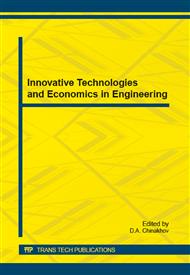[1]
S. D. Siegmann, C. A. Brown, Investigation of substrate roughness in thermal spraying by a scale-sensitive 3-D fractal analysis method, 15th international thermal spray conference – thermal spray: meeting the challenges of the 21st century, Nice, France, 1998, pp.831-836.
DOI: 10.31399/asm.cp.itsc1998p0831
Google Scholar
[2]
R.S.C. Paredes, S.C. Amico, A.S.C.M. D'Oliveira The Effect of roughness and pre-heating ting of substrate on the morphology of aluminum coatings deposited by thermal spraying / Surface and Coatings Technology. 2006. T. 200, № 9, pp.3049-3055.
DOI: 10.1016/j.surfcoat.2005.02.200
Google Scholar
[3]
R.W. Smith, R. Novak, Advanced and application in U.S. thermal spray technology, Powder Metallurgy International. 3(1991) 147-156.
Google Scholar
[4]
Zh.G. Kovalevskaya, Yu.F. Ivanov, O.B. Perevalova, V.A. Klimenov, P.V. Uvarkin, Study of microstructure of surface layers of low carbon steel after turning and ultrasonic finishing, The Physics of Metals and Metallography. 114 (2013) 41–53.
DOI: 10.1134/s0031918x12110105
Google Scholar
[5]
A.I. Lotkov, A.A. Baturin, V.N. Grishkov, Zh.G. Kovalevskaya, P.V. Kuznetsov, Effect of ultrasonic plastic treatment on the surface structure and phase state of nickel titanium, Technical Physics Letters. 31 (2005) 912-914.
DOI: 10.1134/1.2136950
Google Scholar
[6]
A.V. Filippov. Constructing a model of the equivalent wedge oblique cutting edge. Applied Mechanics and Materials Vol. 379 (2013) pp.139-144. Trans Tech Publications, Switzerland.
DOI: 10.4028/www.scientific.net/amm.379.139
Google Scholar
[7]
V.A. Klimenov, Zh.G. Kovalevskaya, V. Yu. Borozna, Sun Zeming, Zhu Qifang, Nanocrstallization surface treatment of titanium alloys, Rare Metals. 28 (2009) 195-198.
Google Scholar
[8]
V.A. Klimenov, Yu.F. Ivanov, O.B. Perevalova, Z.G. Senchilo, Structural and phase transformation in the Ni- and Fe- based plasma coating under the effect of high energy, Materials and manufacturing. 12 (1997) 849–861.
DOI: 10.1080/10426919708935189
Google Scholar
[9]
V.A. Klimenov, Zh.G. Kovalevskaya, K.V. Zaitzev, A.I. Tolmachov, Adhesion obtained by high velocity oxygen fuel thermal spray process, Bulletin of the Tomsk Polytechnic University. 310 (2007) 52-55.
Google Scholar
[10]
V.A. Klimenov, Z.G. Kovalevskaya, V.Y. Ul'yanitskii, K.V. Zaitsev, V.Y. Borozna, Effect of ultrasonic treatment of the substrate on the formation of the coating in detonation spraying, Welding International. 24 (2010) 803-807.
DOI: 10.1080/09507116.2010.486193
Google Scholar


